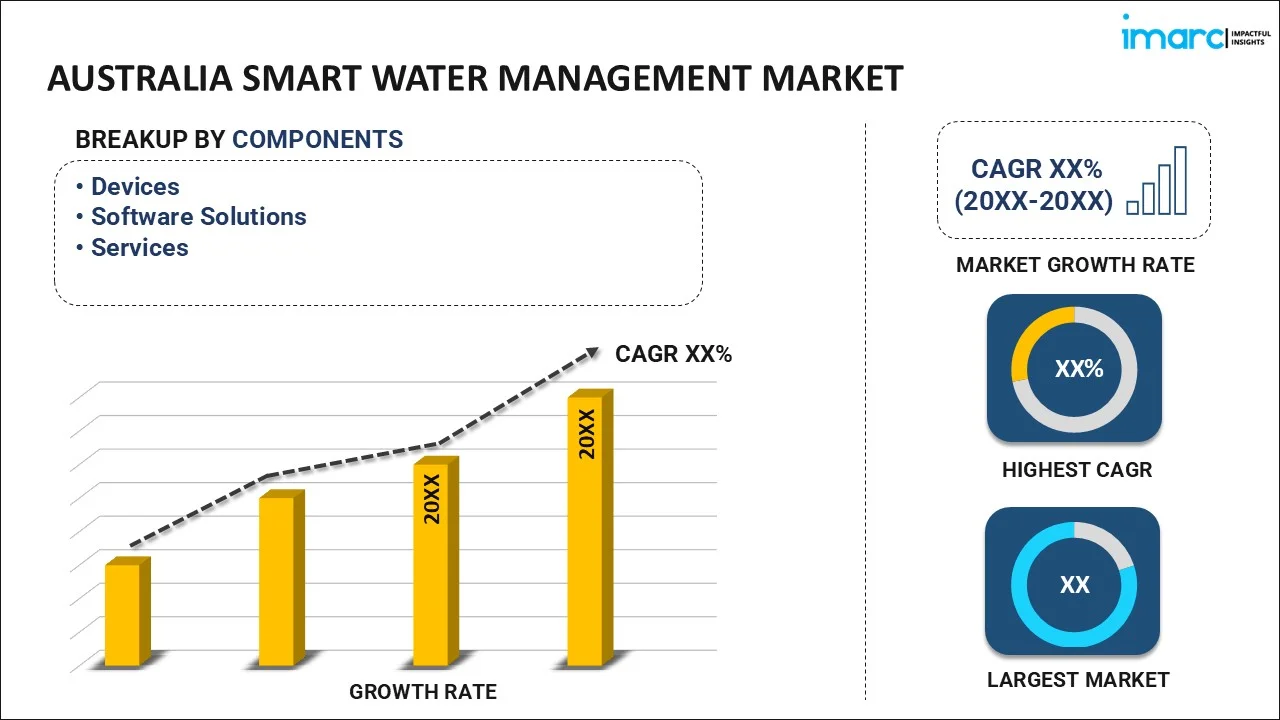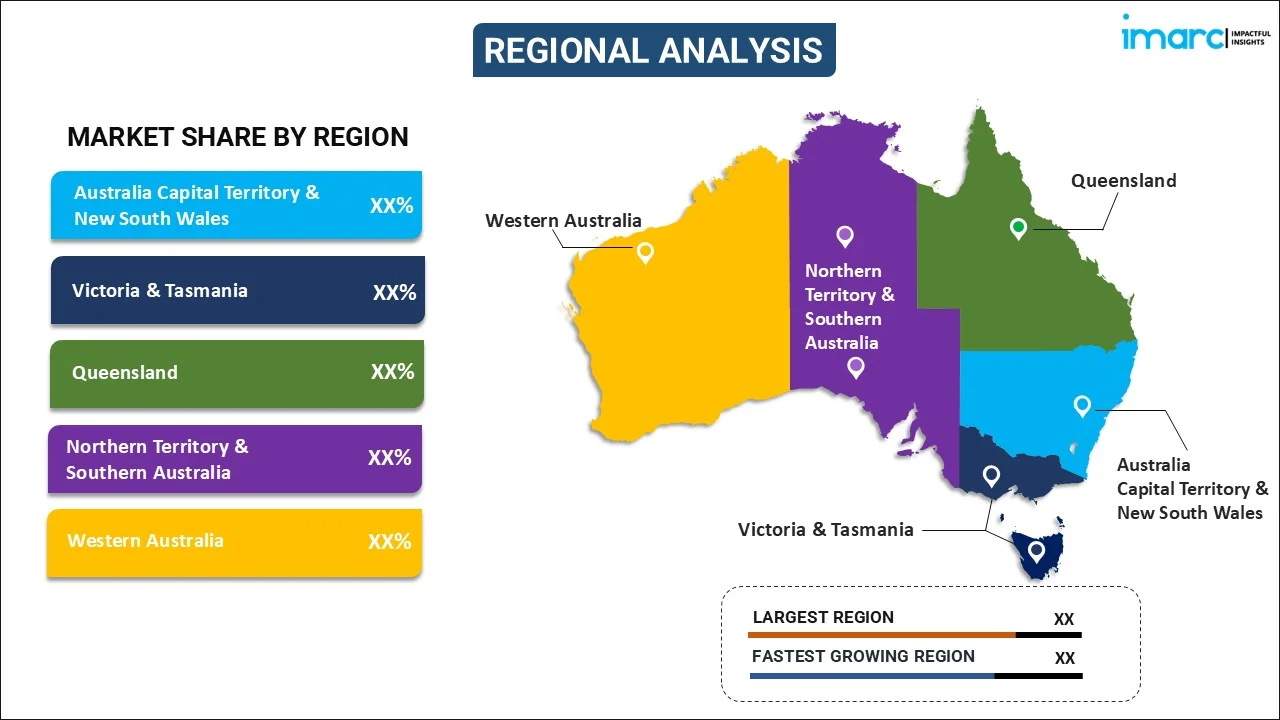
Australia Smart Water Management Market Size, Share, Trends and Forecast by Component, Application, and Region, 2025-2033
Australia Smart Water Management Market Overview:
The Australia smart water management market size reached USD 274.40 Million in 2024. Looking forward, IMARC Group expects the market to reach USD 975.93 Million by 2033, exhibiting a growth rate (CAGR) of 13.70% during 2025-2033. Water scarcity and population growth drive Australia smart water management market share, ensuring efficient distribution and conservation. Technological advancements also enhance monitoring, leak detection, and predictive analytics for sustainable resource utilization. Moreover, regulatory support enforces conservation policies, promotes digital transformation, and incentivizes smart infrastructure investments, strengthening Australia’s water security and sustainability efforts.
|
Report Attribute
|
Key Statistics
|
|---|---|
|
Base Year
|
2024
|
|
Forecast Years
|
2025-2033
|
|
Historical Years
|
2019-2024
|
| Market Size in 2024 | USD 274.40 Million |
| Market Forecast in 2033 | USD 975.93 Million |
| Market Growth Rate (2025-2033) | 13.70% |
Australia Smart Water Management Market Trends:
Water Scarcity and Population Growth
Water shortage and population expansion are driving the implementation of smart water management solutions in Australia. By June 30, 2024, the population of Australia stood at 27,204,809 residents, indicating a quarter-over-quarter growth of 89,185 citizens (0.3%). Expansion in urban areas imposes tremendous stress on available water resources, calling for efficient distribution and conservation measures. Climate change exacerbates drought, and real-time monitoring becomes critical to ensure sustainable water allocation and management. Smart water meters enable people to monitor usage, ensuring prudent usage and minimizing the overall wastage of water. Internet of Thing (IoT) sensors enable early leak detection to avoid substantial loss and ensure optimum use of the resource in zones. Predictive analytics predict pattern-based demand and enable utilities to adopt preventive approaches to sustainable supply management of water. Automated watering systems ensure agriculture optimizes its water usage and delivers required watering to crops without overconsumption. Desalination facilities incorporate smart technologies, enhancing operational effectiveness and minimizing reliance on conventional freshwater supplies. Cloud-based systems support remote monitoring, allowing authorities to manage water supply and react to emergencies effectively. Growth in population elevates industrial demand for water, prompting the implementation of high-tech treatment and recycling solutions.
Technological Advancements
Technological innovation is improving the effectiveness and efficiency of smart water management in Australia. Smart water meters allow for real-time monitoring, minimizing wastage and maximizing conservation in both urban and rural regions. IoT sensors assist utilities in early detection of leaks, avoiding losses and maximizing resource efficiency. Advanced data analytics offer predictive capabilities, enabling water authorities to forecast demand variability and infrastructure failures. For instance, in December 2024, New South Wales' top water utility company, Hunter Water, began piloting advanced digital water meters on its service area. The program comprises installing 500 digital meters at houses and commercial businesses, such as 50 local companies, to provide real-time water consumption data refreshed every 30 minutes. This project would maximize water management, reinforce leak detection, and offer customers extensive consumption information. The technology facilitates early identification of leaks to allow rapid response to save water and reduce costs. Moreover, cloud-based solutions simplify the gathering of data, facilitating remote monitoring and anticipatory decision-making for sustainable water supply. Artificial intelligence (AL) improves water treatment processes, maximizing operational performance and minimizing utilities' maintenance expenses. Automated irrigation enhances agricultural water use, providing proper water supply to crops without unnecessary usage. Blockchain technology provides transparency in water trade, increasing accountability in water management stakeholders. Digital twin simulations simulate water networks, detects inefficiency and enhances infrastructure, resulting in a favorable Australia smart water management market outlook.
Regulatory Support
Regulatory support is accelerating the adoption of smart water management solutions across Australia’s water infrastructure sector. The Government of Australia is estimated to spend 439.23 million AUS, in 2025-26, for infrastructure and sustainable rural water use program, under Murray–Darling Basin programs, launched in 2007-2008. Besides this, government policies mandate sustainable water practices, encouraging utilities to invest in advanced monitoring and conservation technologies. Strict water conservation regulations drive the implementation of smart meters, reducing waste and improving consumption efficiency. Environmental laws promote wastewater recycling, leading to increased adoption of advanced treatment technologies, which further strengthens the Australia smart water management market growth. Subsidies and grants incentivize municipalities to integrate IoT-based leak detection systems for reducing water loss. State-level policies enforce digital transformation, ensuring utilities modernize infrastructure with data-driven smart water management solutions. National water security frameworks emphasize predictive analytics, enabling proactive responses to climate-induced supply fluctuations. Regulatory bodies require transparency in water usage data, pushing utilities toward blockchain-based tracking systems. Industry standards for efficient irrigation practices encourage widespread adoption of automated agricultural water management technologies. Compliance with emissions targets propels investment in energy-efficient water treatment and distribution systems.
Australia Smart Water Management Market Segmentation:
IMARC Group provides an analysis of the key trends in each segment of the market, along with forecasts at the regional level for 2025-2033. Our report has categorized the market based on component and application.
Component Insights:

- Devices
- Advanced Water Meters
- Meter Read Technology
- Software Solutions
- Asset Management
- Distribution Network Monitoring
- Supervisory Control and Data Acquisition (SCADA)
- Meter Data Management (MDM)
- Advance Analytics
- Others
- Services
- Managed Services
- Professional Services
The report has provided a detailed breakup and analysis of the market based on the component. This includes devices [advanced water meters and meter read technology]; software solutions [asset management, distribution network monitoring, supervisory control and data acquisition (SCADA), meter data management (MDM), advance analytics, and others]; and services [managed services and professional services].
Application Insights:
- Residential
- Commercial and Industrial
A detailed breakup and analysis of the market based on the application have also been provided in the report. This includes residential and commercial and industrial.
Regional Insights:

- Australia Capital Territory & New South Wales
- Victoria & Tasmania
- Queensland
- Northern Territory & Southern Australia
- Western Australia
The report has also provided a comprehensive analysis of all the major regional markets, which include Australia Capital Territory & New South Wales, Victoria & Tasmania, Queensland, Northern Territory & Southern Australia, and Western Australia.
Competitive Landscape:
The market research report has also provided a comprehensive analysis of the competitive landscape. Competitive analysis such as market structure, key player positioning, top winning strategies, competitive dashboard, and company evaluation quadrant has been covered in the report. Also, detailed profiles of all major companies have been provided.
Australia Smart Water Management Market News:
- In December 2024, Itron, Inc., a global leader in energy and water management solutions, partnered with TasWater, Tasmania’s sole water and sewage utility, to implement its cloud-based Temetra platform. This system simplifies and centralizes meter data collection, allowing TasWater to obtain frequent and precise water usage data via drive-by or walk-by readings. Temetra enhances operational efficiency, minimizes billing errors, and improves customer experience.
- In July 2024, Genus Power Infrastructures Limited, a leading provider of smart metering technology, successfully shipped its first batch of Smart Ultrasonic Water Meters to Australia. These advanced meters comply with international standards OIML R49 and MID, offering R400 accuracy and an IP68 rating for superior performance and durability. Featuring LoRa communication technology, they enable remote monitoring and management, enhancing smart water distribution. With NMI and WaterMark approvals, these meters meet stringent quality and safety standards, reinforcing their reliability for efficient water management solutions.
Australia Smart Water Management Market Report Coverage:
| Report Features | Details |
|---|---|
| Base Year of the Analysis | 2024 |
| Historical Period | 2019-2024 |
| Forecast Period | 2025-2033 |
| Units | Million USD |
| Scope of the Report |
Exploration of Historical Trends and Market Outlook, Industry Catalysts and Challenges, Segment-Wise Historical and Future Market Assessment:
|
| Components Covered |
|
| Applications Covered | Residential, Commercial and Industrial |
| Regions Covered | Australia Capital Territory & New South Wales, Victoria & Tasmania, Queensland, Northern Territory & Southern Australia, Western Australia. |
| Customization Scope | 10% Free Customization |
| Post-Sale Analyst Support | 10-12 Weeks |
| Delivery Format | PDF and Excel through Email (We can also provide the editable version of the report in PPT/Word format on special request) |
Key Questions Answered in This Report:
- How has the Australia smart water management market performed so far and how will it perform in the coming years?
- What is the breakup of the Australia smart water management market on the basis of component?
- What is the breakup of the Australia smart water management market on the basis of application?
- What are the various stages in the value chain of the Australia smart water management market?
- What are the key driving factors and challenges in the Australia smart water management market?
- What is the structure of the Australia smart water management market and who are the key players?
- What is the degree of competition in the Australia smart water management market?
Key Benefits for Stakeholders:
- IMARC’s industry report offers a comprehensive quantitative analysis of various market segments, historical and current market trends, market forecasts, and dynamics of the Australia smart water management market from 2019-2033.
- The research report provides the latest information on the market drivers, challenges, and opportunities in the Australia smart water management market.
- Porter's five forces analysis assist stakeholders in assessing the impact of new entrants, competitive rivalry, supplier power, buyer power, and the threat of substitution. It helps stakeholders to analyze the level of competition within the Australia smart water management industry and its attractiveness.
- Competitive landscape allows stakeholders to understand their competitive environment and provides an insight into the current positions of key players in the market.
Need more help?
- Speak to our experienced analysts for insights on the current market scenarios.
- Include additional segments and countries to customize the report as per your requirement.
- Gain an unparalleled competitive advantage in your domain by understanding how to utilize the report and positively impacting your operations and revenue.
- For further assistance, please connect with our analysts.
 Inquire Before Buying
Inquire Before Buying
 Speak to an Analyst
Speak to an Analyst
 Request Brochure
Request Brochure
 Request Customization
Request Customization




.webp)




.webp)












